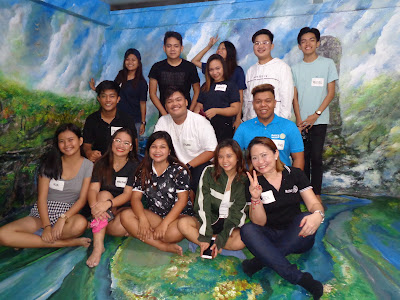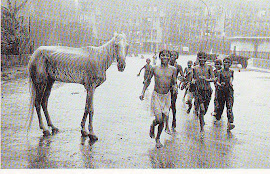STI Rotaract club Vigan City Integrated Art Workshop
"Art enables us to find ourselves and lose ourselves at the same time." Thomas Merton**
Dr Abe V Rotor
Art InstructorLiving with Nature Center, San Vicente Ilocos Sur
A pool of colors
Painting with the hand beside the brush freely releases
these ardent young painters the expressions of their thoughts,
emotions, and imaginations happily and courageously.
The Hand
The hand speaks of the mind and the heart,
actions good and evil, and deed,
mirrors the spirit, cast the rainbow of life;
imprint of one's life indeed.
The Way
Wonder to where the road leads,
the stream of life flows,
the stars in time and space,
as a man or woman grows.
Protolife
Living but for a moment like passing breeze,
haploids of heredity searching their other halves - -
the wholeness of procreation - omnipotent,
singular, mysterious, beyond man's grasp.
Crossing the Bar*
For though from out our bourne of Time and Place
The flood may bear me far,
I hope to see my Pilot face to face
When I have crossed the bar.
*Last stanza of Crossing the Bar is an 1889 poem by Alfred, Lord Tennyson. It is considered that Tennyson wrote it in elegy; the narrator uses an extended metaphor to compare death with crossing the "sandbar" between river of life, with its outgoing "flood," and the ocean that lies beyond [death], the "boundless deep", to which we return. (en.wikipedia.org) AUTHOR's NOTE: The original title given by the painter is "Prison in the Sky"
Home, Sweet Home - The Bahay Kubo
Above the doves of peace and unity,the glow of burning light of the city;endlessly rages the sea down below,belies this bastion of long ago,
* August 11, 2019 - Rotaract clubs bring together people ages 18-30 to exchange ideas with leaders in the community, develop leadership and professional skills, and have fun. Rotaract originally began as a Rotary International youth program in 1968 at Charlotte North Rotary Club in Charlotte, North Carolina, United States, and has grown into a major Rotary-sponsored organization of over 10,904 clubs spread around the world and 250,792 members in 184 countries. Motto: Self Development - Fellowship Through Service
** Thomas Merton (1915-1968) was a writer and Trappist monk at Our Lady of Gethsemani Abbey in Kentucky. His writings include such classics as The Seven Storey Mountain, New Seeds of Contemplation, and Zen and the Birds of Appetite. Merton is the author of more than seventy books that include poetry, personal journals, collections of letters, social criticism, and writings on peace, justice, and ecumenism. ~



















































